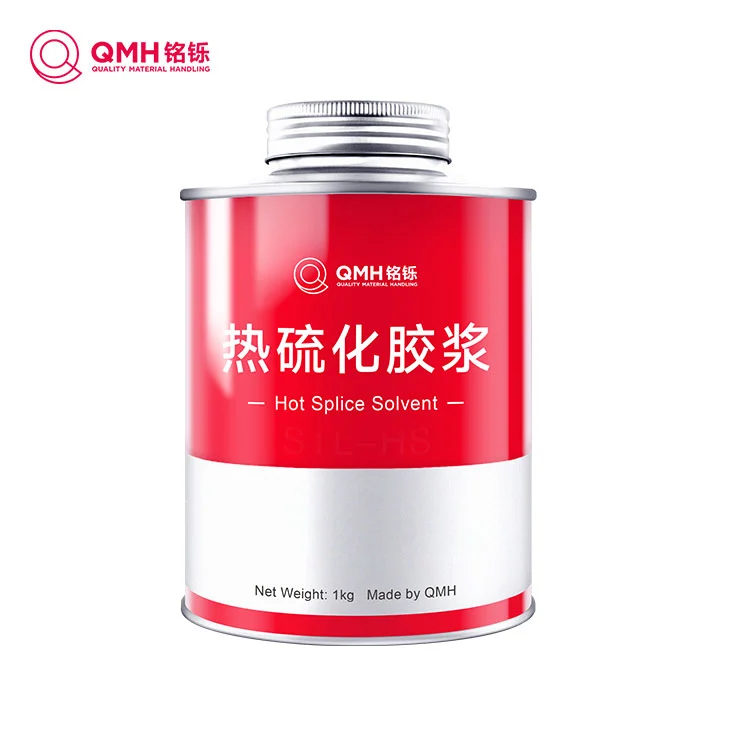QMH conveyor belt hot splice solvent is a flame-retardant high-performance adhesive with the characteristics of high temperature resistance, water resistance, oil resistance, aging resistance, and high bonding strength. It is widely used in the vulcanization and bonding of various rubber conveyor belts, steel cord conveyor belts, whole core conveyor belts, nylon, canvas, and polyurethane conveyor belt joints. When hot-vulcanized adhesive joints are hot-vulcanized, they need to be used with unvulcanized core rubber and surface rubber.
Send Inquiry
● (Hydrocarbons, C7-C9, normal alkanes, isoalkanes) 50%-100%
● Zinc oxide 0.3%-1.0%
● Extract (petroleum), heavy paraffin fraction solvent 0.25%-1%
● Cobalt 2-ethylhexanoate 0.1%-0.25%
1. Ingredients:
(Hydrocarbons, C7-C9, normal alkanes, isoalkanes) 50%-100%
Zinc oxide 0. 3%-1. 0%
Extract (petroleum), heavy paraffin fraction solvent 0. 25%-1%
Cobalt 2-ethylhexanoate 0. 1%-0. 25%
2. Vulcanization principle:
Under heating conditions, the vulcanizer reacts chemically with the rubber molecules to form a cross-linked structure between the rubber molecular chains, thereby improving the physical properties of the rubber, such as strength, elasticity, wear resistance, and aging resistance. As an intermediate medium, the hot vulcanized glue firmly combines different rubber parts together through the vulcanization reaction to form a whole during the bonding or repair of rubber products.
1. High-strength bonding:
QMH conveyor belt hot splice solvent can achieve high-strength bonding between rubber and rubber, rubber and metal and other materials. The bonding strength can be close to or even reach the strength of the rubber itself, ensuring that the bonding parts will not fall off or separate easily during use, and meet the strict requirements of various industrial applications for bonding strength.
2. Good adaptability:
QMH hot splice solvent has good adaptability to a variety of rubber materials, such as natural rubber, synthetic rubber, etc., and can form a firm bond with the surface of different rubber products. It is not limited by the type of rubber, which expands its application range in the rubber industry.
3. Chemical corrosion resistance:
QMH hot splice solvent has certain chemical corrosion resistance. When it comes into contact with some chemical substances, such as acid and alkali solutions, grease, lubricants, etc., the bonding parts can still maintain good performance and are not easily corroded or damaged, ensuring the normal use of rubber products in complex chemical environments.
4. Strong operability:
QMH hot splice solvent usually has suitable viscosity and fluidity, is easy to apply on the bonded surface, can evenly cover the bonding area, is easy to operate, and can be applied by brushing, spraying, dipping and other methods to meet the needs of different production processes and maintenance scenarios.
1. Rubber product manufacturing:
In the production process of rubber products such as tires, conveyor belts, hoses, seals, etc., hot-vulcanized adhesive is used to bond different parts or repair defects in the production process, such as bonding the tire tread and the carcass, making conveyor belt joints, connecting hoses, etc., to ensure the quality and performance of the product.
2. Repair of rubber products:
For rubber products that are damaged, cracked, debonded, etc. during use, hot vulcanized adhesive can be used for on-site repair. By heating and vulcanizing, the repair material is firmly bonded to the original rubber product, restoring its function and performance, extending its service life, and reducing maintenance costs and replacement frequency.
3. Maintenance of industrial equipment:
In some industrial equipment, such as mining machinery, chemical equipment, papermaking machinery, etc., the connection or sealing between rubber parts and metal parts is often bonded with hot vulcanized adhesive to ensure the normal operation of the equipment and prevent leakage, loosening and other problems.
1. Perform step-by-step treatment on the ordinary layered conveyor belt. After the treatment, use an angle grinder with a tungsten steel grinding disc to grind the step surface in a roundabout way;
2. Apply the hot splice solvent evenly on the grinding area and the unvulcanized core rubber and surface rubber, and lay the core rubber and surface rubber on the step area;
3. Use a vulcanizer to heat and pressurize the joint surface. When the temperature reaches 145℃, it needs to be kept constant for 40-45 minutes. After the time is up, stop heating. After the vulcanizer cools down, remove the vulcanizer and use a rubber knife to repair the joint of the conveyor belt. After trimming, the vulcanization is completed.
1. Surface treatment:
Before using QMH conveyor belt hot splice solvent, the bonded surface needs to be thoroughly cleaned and treated to remove impurities such as oil, dust, and rust. Sandpaper polishing, chemical cleaning and other methods can be used to improve the surface roughness and activity to ensure good contact and bonding between the adhesive and the surface.
2. Solvent application control:
The amount of solvent should be reasonably controlled according to the bonding area and the shape of the parts to avoid excessive or insufficient glue. Excessive solvent application will cause the adhesive to overflow during the vulcanization process, affecting the appearance and performance; too little solvent application may cause insufficient bonding strength and debonding.
3. Vulcanization condition control:
Strictly control the vulcanization temperature, time and pressure and other conditions according to the instructions for use of the adhesive. Too high a temperature or too long a time may cause the rubber to be over-vulcanized, making the bonding part brittle and the performance deteriorating; too low a temperature or too short a time will make the vulcanization reaction incomplete and the bonding strength insufficient.
4. Safety protection:
The solvent in the hot splice solvent is usually volatile and toxic. During use, good ventilation should be paid attention to. Operators should wear protective gloves, masks, goggles and other protective equipment to avoid skin contact and inhalation of volatile gases to prevent harm to the human body.

If you have any enquiry about quotation or cooperation, please feel free to email or use the following inquiry form. Our sales representative will contact you within 24 hours.